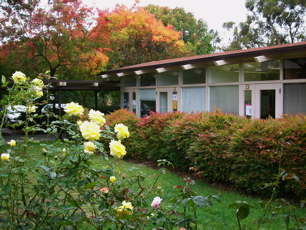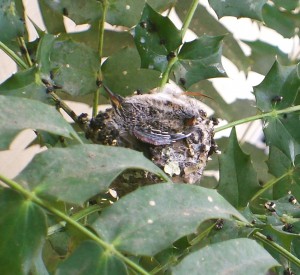There are places in Silicon Valley where you can stand along the edge of San Francisco Bay and look back at the Coastal Range, and during the summer you can watch as the fog from the Pacific Ocean spills over the low points in the ridge line. On the other side of the Coastal Range, an ocean current hits the shore line, and deep cold water comes to the surface where it meets warmer air, and condenses into fog. The fog will build up until it’s five hundred or a thousand feet high, high enough to spill over the low points in the ridge. You can watch the fog working its way down through the distant woodlands some miles away and hundreds of feet higher than where you stand, down at sea level, in the warm bright sunshine of Silicon Valley.
Tag Archives: Palo Alto
300
In the middle of the afternoon, I took a break and slipped off the Baylands Nature Preserve. A light breeze, gusting to a moderate breeze, came from a little west of north, and brought the smell of salt water of the bay with it. I felt a little cold, and thought about going back to the car to get my fleece vest, but decided to keep walking. The tide was just beginning to come in, and there were so many shore birds all over the mudflats — American Avocets, Marbled Godwits, Willets, Western Sandpipers — that I spent most of my time looking down at the mud, not up at the sky.
Then a huge something flew overhead. I looked up in time to see a big white bird with black wing tips gliding low over the salt marsh. I didn’t even need to look at its head to know that it was an American White Pelican (Pelecanus erythrorhynchos). I’ve seen plenty of Brown Pelicans, but somehow I had never seen a White Pelican before today. And I didn’t just see the one; as I got farther out the dike trail, I saw half a dozen more gliding overhead, and after I had walked about a mile I saw more than twenty more sitting in the marsh about two tenths of a mile away from the dike.
The American White Pelican was the three hundredth species of bird that I’ve positively identified. I’m not a very good birder, and the main reason that I’ve managed to see that many species of birds is that I’ve lived on the east coast, on the west coast, and in the midwest. And I have to admit that it has taken me more than forty years to see that many species — I can positively remember seeing a Rufous-sided Towhee for the first time in July, 1967, when I was six years old, so I can date the beginning of my birding career no later than then. Nevertheless, I certainly felt a little thrill go through me this afternoon when I realized that I was indeed seeing an American White Pelican, a bird I had never seen before.
I spent a good ten minutes watching one White Pelican feeding at the edge of one of the sloughs in the Baylands Preserve: sticking out its neck as it floated along and running its long peach-colored bill through the water, then putting its head back so I could see its somewhat distended throat sac. And I spent a fair amount of time watching three or four of them flying together: these huge birds with a wingspan of up to 120 inches in close formation, gliding along and barely flapping their wings. It was certainly a dramatic way to reach the three hundred species milestone.
Summer-dry season
This afternoon, I took a break from not writing the things I’m supposed to be writing, and went out to the Baylands nature preserve for a walk.
We’re now fully into the summer-dry season. The plants all look drab: The grasses are crispy and dry; they have faded beyond golden-brown to pale golden-brown. The leaves of the trees have become dull green. Even the cattails, with their feet sunk into damp soil in the marshes, are not as green as they are in the spring.
Away from the bay, I didn’t see many animals: I saw one gopher, heard and insect or two, saw one small brown bird flitting from one bit of cover to another bit of cover. But there was plenty of activity out on the waters and mudflats of the bay. Forster’s Terns were everywhere, diving into the water and sometimes coming up with fish in their bills. Barn Swallows swooped along the edges of the salt marshes, while egrets hunted in the shallow waters near by. Hundreds of shore birds plunged their bills into the mud left behind by low tide.
Hummingbird babies
The Anna’s Hummingbird who is nesting next to our main worship space has hatched two babies:
The photo above is far from perfect — the light level is low necessitating a relatively long exposure, and the babies won’t keep still even when I ask them politely. Nevertheless, you should be able to see the bill of one pointing to the left, and the bill of the other one at the right of the nest pointing toward and above the camera; the bills are quite a bit shorter relative to the body than the bill of a mature hummingbird. The baby on the left has its wing spread out over the top of the nest, and you can see the fine white and black pattern of the developing primary feathers.
Getting distracted
“It’s four o’clock,” I said, “the train will be here soon.” Carol started to get out of the car, and then said, “Oh look!” and pointed at the rainbow. It was low in the sky, and quite vivid.
She ran off to catch her train. I started driving back to the office, and managed to miss my turn because I was looking at the rainbow, which had faded and had lost the top of its arch.
I drove around in one of those suburban tracts where you can never go in the direction you think you want to go. I was a little bit embarrassed that I had gotten lost because I was looking at a rainbow; rainbows are so wonderful that they’re trite; little kids like rainbows; I’m sure the other adults who driving around didn’t bother looking at the rainbow, although they might have had a little kid in a car seat who pointed at it.
Eventually I got back on the right road again. I came back to the office, and didn’t think about the rainbow until just now.
Winter
When I was out at Baylands Preserve a couple of days ago, I happened to look up at the hills floating above the low haze on the other side of San Francisco Bay. All summer long they have been sere and brown, but now they are tinted a delicate green.
Not teaching, but still doing religious education
One in a series of entries in my teaching diary. First 2009 entry.
Sunday 27 December 2009
There was no Sunday school today, so I got to go to church to hear the sermon. I arrived a little bit late, and sat down just before the opening words. I could see Marco and Natalie sitting on the other side of the Main Hall with their godmother; I tried to catch Marco’s eye, but I don’t think he noticed me. Roger Jones, the visiting preacher, gave an excellent sermon — I was glad our church brought in a really good guest preacher on this low-attendance Sunday. Marco and Natalie stayed in for the whole worship service, and Roger’s sermon was good enough that I suspect Marco (and maybe Natalie) could pick up something from it; at the very least, the children got to hear the speech rhythms of a good preacher, rhythms which can be hypnotic and entrancing in their own right. I wanted to try to talk to Marco and Natalie after the service to see what they thought about it, but unfortunately I had to leave immediately; but I will make a point of asking them about it the next time I see them.
Later in the afternoon, I took a break and went over to the Baylands Nature Preserve, to go for a walk, and to do some birding. There were hundreds of wintering ducks in the marshlands, and I was standing on one of the dikes looking through my binoculars at a pair of Gadwall when I heard a familiar voice saying, “I don’t know if Dan wants to be disturbed.” It was Lucy, standing there talking to her daughter Dorit, who is in my Sunday school class.
I said hello to both of them. Lucy said she didn’t want to bother me, but I told her (truthfully) that I was pleased to see them both. Dorit is now six and three-quarters. I began talking to her about birds, and quickly figured out that she was interested in birds, and had some basic knowledge of how to tell different kinds of birds apart. “Would you like to look through my binoculars?” I said. Dorit nodded, and we went over to a nearby bench so I could sit next to her (when you’re six foot five, you either have to kneel down or sit beside a child when you’re going to let them use your binoculars, and it was too damp for me to want to kneel). The three of us sat on a bench looking out at tidal flats with American Avocets, various kinds of ducks, and lots of shorebirds. I asked Dorit if she knew how to use binoculars, and she did — she held them up, managed to hold them steady, and used the focusing knob. They were kind of heavy for her, though, and not much fun to use. So we just sat there looking at the birds without binoculars. It was a little chilly, and after we talked for about five minutes, Lucy and Dorit went off one way, and I went off the other way.
Strictly speaking, birds have nothing to do with religious education. But I remember that I liked it when the adults in my childhood church shared their interests and passions with me — it was nice to be treated by adults as a person instead of a child. So talking to Dorit about birding may have nothing to do with religion, but it has everything to do with being human; which I suppose is just another way of saying that it has everything to do with religion.
Another
Another teen from Palo Alto has died on CalTrain tracks — the fourth in six months. The local newspaper simply refers to a fatality, but the word-of-mouth version of the story says the death was a suicide. This is not good — not good at all.
Fall color in Palo Alto
That’s the office wing here at church, with roses in full bloom in the foreground, while at the same time leaves on trees and shrubs are turning bright red and orange. The recent rains and humidity have made the grass look much greener (in-ground sprinklers just aren’t as effective as rain).

(My office is the one with the lights on.)

